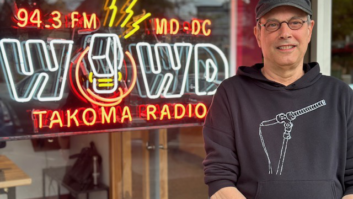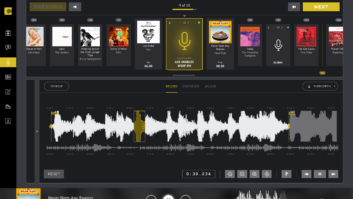Over the past three years, the marketplace has been flooded with digital audio recorders that use Flash memory for storage. In the rapid fire introduction of new models, the one constant has been progressively lower prices. We’ve now reached the point that digital sound recording is available for less than $200.
However, the old adage that you “get what you pay for” most certainly applies here. For heavy users of field audio recorders, such as radio journalists, buying at too low a price can be akin to making a deal with the devil.
The low-cost compromise usually comes in two areas: sound quality and durability. Cheap mics and preamps — a staple of many low-end recorders — can be very noisy. User interfaces can be clunky and hard to see in low light. Poorly made battery compartments break after the repeated changing of cells. And a single drop to a concrete floor can easily end the life of a recorder housed in a thin plastic case.
The best choices for serious audio field recordists cost about as much as a decent laptop computer, in the range of $2,000. They include the excellent Sound Devices 702 field recorder ($1,875 street) and the Sony PCM-D1 ($1,749 street).
Though each of these recorders represents excellence for its design type, the Sony — because of its built-in microphones, user simplicity and rugged titanium body — has been the Rolls-Royce of digital recorders for “one-man-bands.”
That is until now. Hip to the fact that the PCM-D1 was out of the price range for many broadcasters and audio recordists, Sony did something smart. It took many of the best parts of the D1 design and built a smaller, lower-cost version.
(click thumbnail)But what’s really smart about the new Sony PCM-D50 ($599 retail, $500 street) is that the engineers at Sony didn’t get caught up in the race to build it cheap. They built it right.
Ready for the pros
As the owner and user of a PCM-D1 since it came on the market in 2005, I am accustomed to the D1’s sonic quality, intuitive user interface, rugged design and quick-change cartridge battery system. Combined, these essential features make the recorder dependable for daily professional use.
All of these features migrated to the D50. It’s the same user interface and rock-solid operating software; the same four gigabytes of internal memory (expandable to 8 GB with an optional memory stick); and the identical battery system. Rather than using one millimeter-thick pure titanium, Sony chose aluminum for the D50 case. No cheap plastic.
What you don’t get with the D50 is the D1’s superior Analog Devices AD797 low-distortion preamps, high-grade microphone capsules and other premium components. If the application is live music recording and you’re willing to pay for the quality, the D1 is still the best choice. However, for general-purpose field recording and radio applications, the D50’s sonic quality is just fine.
The D50, at 2.7 x 6.1 x 1.5 inches, is lighter and more compact than the D1. Where the D1 weighs in at 18.5 ounces, the D-50 lightens the load to 12.8 ounces (including battery). The D1 may not seem much smaller and lighter, but it makes a huge difference when you carry an audio recorder in your bag all day.
The D50 also adds some desirable features missing from the D1. Most notably, it has optical digital inputs and outputs in addition to the standard mic and line I/Os. It also adds switchable 2.71 volt plug-in power at the mini microphone connector, which can be used for powering low-voltage condenser microphones.
As with the D1, the D50 is a 96 kHz/24 bit recorder. However, with the typical radio usage being at 44.1 kHz/16 bits, the D50 can provide up to 14 hours of operation on four AA alkaline batteries. Rechargeables also can be used.
Unique to the D50 is a new two-position stereo mic array for 90 degree (X-Y) or 120 degree wide recording; a pre-record buffer that captures five seconds of audio before hitting the record switch; and a variable digital pitch control (DPC).
Other features include the ability to divide a recorded track; synchronized recording via digital connection from CD, MD or DAT; and playback of MP3 files copied from a computer.
One of the nice carryovers from the D1 is that the D50 also acts as a removable storage device on computers. That means you simply turn it on and connect the recorder via USB to a Macintosh or PC. Within seconds, it shows up on the desktop as a hard drive. Then it’s just a matter of dragging the standard WAV files to the computer. No conversion software or drivers are needed.
Other D50 refinements include hard switches on the back of the recorder for controlling the limiter and low-cut filter. The DPC switch is on the recorder’s side, along with mic/line and mic attenuator switches.
Product CapsuleSony PCM-D50 Digital Field Recorder
Thumbs Up

- Excellent sound quality
- Simple user interface
- Flexible digital and analog I/Os
- Rugged, aluminum case
- 4 GB built-in Flash memory
- Pro-quality quick-change battery compartment
- Good balance of performance for price
Thumbs Down:
- Consumer-type I/O connectors
- XLR adapter is expensive and bulky
- Essential windscreen for outdoor use is optional accessory
- Memory expansion requires proprietary memory stick
Price
$599 MSRP
Contact
Sony | (800) 686-SONY (7669) | www.sony.com/professionalIn the menu, however, the limiter can be set at 150 milliseconds, one second or one minute. Low-cut options include 75 Hz and 150 Hz. Also available in the menu is Sony Super Bit Mapping for 44.1/16 recording, a feature designed to increase the dynamic range acoustically by reducing noise.
Another difference with the D1 is the D50’s omission of the analog VU meters. Some felt these meters were redundant with the LCD metering on the D1, but I like them because they are easy to see from a distance and offer old-school reassurance when recording interviews.
The D50, made more compact by omission of these meters, offers a visual assurance in the form of a pair of LEDs for each channel. A green light signals that the recording level is in the range between –12 and –1 dB. A red light alerts that the record level exceeds –1 dB.
Essential accessories
My field tests found that the new recorder lives up to the excellent pedigree established by the D1. As a handheld recorder for spoken word interviews and other radio applications, the PCM-D50 is the new sweet spot for price-performance in the digital audio market.
Serious users will require some optional accessories essential for professional use. One is Sony’s Model ADPCM1 furry wind screen. The D50’s mics come unprotected in the basic configuration and this custom-fitting windscreen is absolutely necessary for outdoor work. There’s no way around it.
Another critical accessory is the REPCM1 remote control. It allows use of D50’s controls in record without generating mechanical noise through the built-in mics.
Neither of these accessories was available for our evaluation, but Sony promised their availability at the same time the D50 recorder reaches retail stories (it is now shipping). If you buy a D50, it is best to include these accessories in the original purchase.
Both the D1 and D50 have a 1/4-20 (1/40 inch diameter, 20 threads per inch) screw socket on the bottom. These are the same sockets used on popular SLR digital cameras. These recorders are self-contained with microphones, so recordists will at times want to mount them on a camera tripod or microphone stand for live performances.
Though Sony sells a tabletop tripod stand (VCTPCM1) as an accessory for the D50, any standard camera tripod will do the job. Adapters also are available at photographic supply houses that allow the mounting of these recorders on standard microphone stands.
Finally, there’s the issue of XLR connectors. It’s a sad commentary that after all these years the pro audio industry has failed to standardize on a miniature balanced connector to supplement the standard XLR connector. But that’s the reality and the D50, like the D1, uses consumer-type mini connectors.
Sony offers an expensive accessory, the XLR-1 ($419 street), that adds 48 volt phantom-powered XLR connectors to both recorders. However, when sandwiched together with the recorder, it is a bulky solution requiring separate batteries. It’s enough to make one continue to put up with the compromises of mini connectors.
Sony’s introduction of the PCM-D50 changes the landscape for mid-range digital audio recorders. Having personally owned and used most of the lower-end recorders at one time or another, I can say without doubt that the D50 sets a new price-performance standard and is a candidate to become the next workhorse field recorder of the radio industry. It is that good.












